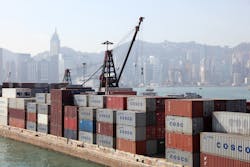Costs continue to mount for security businesses in escalating U.S.-China trade war
Following months of talks between U.S. and Chinese negotiators that many hoped would bring an end to the ongoing trade dispute between the two nations, the Trump administration announced last week that it is raising tariffs on $200 billion of products from China from 10% to 25%. In retaliation, the Chinese government on Monday said that it would be levying tariffs on $60 billion worth of American imports, which would range from 5% to 25%.
This latest round of tariffs will not only mean higher prices for American consumers, but will also significantly impact industries across the board, including security. What will security industry businesses experience? Although the impact of “Chapter 99” is limited, there is a high impact section, but first we need to understand what is subject to the additional 25% duty.
Under this implementing modification summarized by the Office of the United States Trade Representative (USTR), products of China that are covered by the September 2018 action that were exported prior to May 10, 2019, are not subject to the additional duty of 25 percent as long as such products are entered into the United States prior to June 1, 2019. Such products remain subject to the additional duty of 10 percent for a transitional period of time before June 1, 2019. The covered products of China that are entered into the United States on or after June 1, 2019, are subject to the 25 percent rate of additional duty.
Here is a look at some of the products, in decreasing order from high to low impact that will be affected by this latest tariff action:
(Note: The official U.S. Trade Representative’s Office (USTR) document (USTR-2018-0005) are classified in 8-digit subheadings; thus, where possible, the Harmonized Tariff Schedule (HTS) eight digit number will be listed in parentheses for reference purposes)
High Impact
A wide range of solar panels and solar systems used in residential, commercial applications, security lights and “off-grid” camera and communications systems is specified in a very complex manner, citing the following, yet referring to past tariff schedules and multiple citations in the Chapter 99 document, including:
- 10 to 60-watt rectangular solar panels. To put this in perspective, and in an ideal case, a single 50-watt solar panel would be typically used to power five lights of 15 Watts each for four hours every day in a geographic location receiving complete sunshine six hours each day.
- 1-watt solar panels incorporated into nightlights that use rechargeable batteries.
- 2-watt solar panels incorporated into daylight dimmers that may use rechargeable batteries.
- “Off-grid” and portable crystalline silicon photovoltaic panels” (“CSPV panels”) whether in a foldable case or in rigid form containing a glass cover. These are typically used in portable security camera and communications systems.
Since inventory levels may not be high and a small to mid-sized security business is not able to absorb the additional costs in an outright sale or leased solar system, prices will most likely be passed on to the user.
Low Impact
The following are additional goods used in security businesses, either as a service or solution support, that stand to be impacted:
- Light emitting diode (LED) motion-activated security lantern kits, of a kind used for exterior lighting” (9902.17.51).
- Oscilloscopes, digital multimeters, LAN network analyzers, signal generators, OTDR – Optical and wired Time Domain Reflectometers (9902.17.29 - 9902.17.41).
- Projection lenses typically used in LCD projection systems (9902.17.15 - 9902.17.16).
Editor's note: You can catch up on the full list of security products impacted by the Trump administration's tariff list by reading the stories below:
- The Trade War and its Impact on Security
- Security industry impacts from the U.S-China trade war expand
- Security industry braces for third wave of Trump tariffs
- Burglar, fire alarms targeted in latest round of China tariffs
About the Author:
Steve Surfaro is Chairman of the Public Safety Working Group for the Security Industry Association (SIA) and has more than 30 years of security industry experience. He is a subject matter expert in smart cities and buildings, cybersecurity, forensic video, data science, command center design and first responder technologies. Follow him on Twitter, @stevesurf.



